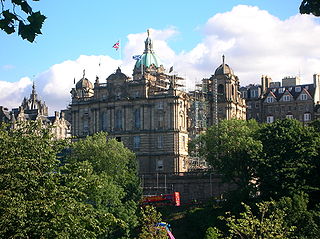
NatWest Group is a British banking and insurance holding company, based in Edinburgh, Scotland.

Northern Rock, formerly the Northern Rock Building Society, was a British bank. Based at Regent Centre in Newcastle upon Tyne, United Kingdom, Northern Rock was originally a building society. It demutualised and became Northern Rock bank in 1997, when it floated on the London Stock Exchange with the ticker symbol NRK.
Frederick Anderson Goodwin FRSE FCIBS is a Scottish chartered accountant and former banker who was Chief executive officer (CEO) of the Royal Bank of Scotland Group (RBS) between 2001 and 2009.
Sir Thomas Fulton Wilson McKillop, FRS, FRSE is a Scottish chemist, who was CEO of AstraZeneca PLC from 1999 until 2006 and chairman of the RBS Group from 2006 until 2008.
The subprime mortgage crisis impact timeline lists dates relevant to the creation of a United States housing bubble and the 2005 housing bubble burst and the subprime mortgage crisis which developed during 2007 and 2008. It includes United States enactment of government laws and regulations, as well as public and private actions which affected the housing industry and related banking and investment activity. It also notes details of important incidents in the United States, such as bankruptcies and takeovers, and information and statistics about relevant trends. For more information on reverberations of this crisis throughout the global financial system see 2007–2008 financial crisis.

In September 2008, the Federal Housing Finance Agency (FHFA) announced that it would take over the Federal National Mortgage Association and the Federal Home Loan Mortgage Corporation. Both government-sponsored enterprises, which finance home mortgages in the United States by issuing bonds, had become illiquid as the market for those bonds collapsed in the subprime mortgage crisis. The FHFA established conservatorships in which each enterprise's management works under the FHFA's direction to reduce losses and to develop a new operating structure that will allow a return to self-management.
The U.S. central banking system, the Federal Reserve, in partnership with central banks around the world, took several steps to address the subprime mortgage crisis. Federal Reserve Chairman Ben Bernanke stated in early 2008: "Broadly, the Federal Reserve’s response has followed two tracks: efforts to support market liquidity and functioning and the pursuit of our macroeconomic objectives through monetary policy." A 2011 study by the Government Accountability Office found that "on numerous occasions in 2008 and 2009, the Federal Reserve Board invoked emergency authority under the Federal Reserve Act of 1913 to authorize new broad-based programs and financial assistance to individual institutions to stabilize financial markets. Loans outstanding for the emergency programs peaked at more than $1 trillion in late 2008."

The bankruptcy of Lehman Brothers on September 15, 2008, was the climax of the subprime mortgage crisis. After the financial services firm was notified of a pending credit downgrade due to its heavy position in subprime mortgages, the Federal Reserve summoned several banks to negotiate financing for its reorganization. These discussions failed, and Lehman filed a Chapter 11 petition that remains the largest bankruptcy filing in U.S. history, involving more than US$600 billion in assets.

HBOS plc is a banking and insurance company in the United Kingdom, a wholly owned subsidiary of the Lloyds Banking Group, having been taken over in January 2009. It was the holding company for Bank of Scotland plc, which operated the Bank of Scotland and Halifax brands in the UK, as well as HBOS Australia and HBOS Insurance & Investment Group Limited, the group's insurance division.
The Emergency Economic Stabilization Act of 2008, also known as the "bank bailout of 2008" or the "Wall Street bailout", was a United States federal law enacted during the Great Recession, which created federal programs to "bail out" failing financial institutions and banks. The bill was proposed by Treasury Secretary Henry Paulson, passed by the 110th United States Congress, and was signed into law by President George W. Bush. It became law as part of Public Law 110-343 on October 3, 2008. It created the $700 billion Troubled Asset Relief Program (TARP), which utilized congressionally appropriated taxpayer funds to purchase toxic assets from failing banks. The funds were mostly redirected to inject capital into banks and other financial institutions while the Treasury continued to examine the usefulness of targeted asset purchases.
The government interventions during the subprime mortgage crisis were a response to the 2007–2009 subprime mortgage crisis and resulted in a variety of government bailouts that were implemented to stabilize the financial system during late 2007 and early 2008.
The Troubled Asset Relief Program (TARP) is a program of the United States government to purchase toxic assets and equity from financial institutions to strengthen its financial sector that was passed by Congress and signed into law by President George W. Bush. It was a component of the government's measures in 2009 to address the subprime mortgage crisis.

In 2008 the Northern Rock bank was nationalised by the British government, due to financial problems caused by the subprime mortgage crisis. In 2010 the bank was split into two parts to aid the eventual sale of the bank back to the private sector.
UK Financial Investments (UKFI) was a limited company set up in November 2008 and mandated by the British government to manage HM Treasury's shareholdings in the Royal Bank of Scotland Group (RBS) and in UK Asset Resolution, which held the residual assets of NRAM plc and Bradford & Bingley. UKFI formerly managed the British government's shares in Lloyds Banking Group, until the government confirmed that all its shares had been sold on 17 May 2017. It also previously owned Northern Rock, until that company was taken over by Virgin Money on 1 January 2012. UKFI ceased trading on 31 March 2018, and its business and assets were transferred to UK Government Investments, a limited company wholly owned by HM Treasury.
Sir John Oliver Frank Kingman KCB FRS has been Chair of Legal & General PLC since 2016. He is also Chair of Barclays UK, the ring-fenced retail bank of Barclays PLC, and a member of the Barclays PLC board. He was previously Chair of Tesco Bank.
A second bank rescue package totalling at least £50 billion was announced by the British government on 12 January 2009, as a response to the then-ongoing Financial crisis of 2007–2008. The package was designed to increase the amount of money that banks could lend to businesses and private individuals. This aid came in two parts: an initial £50 billion made available to big corporate borrowers, and a second undisclosed amount that formed a form of insurance against banks suffering big losses.

The post-2008 Irish banking crisis was when a number of Irish financial institutions faced almost imminent collapse due to insolvency during the Great Recession. In response, the Irish government instigated a €64 billion bank bailout. This then led to a number of unexpected revelations about the business affairs of some banks and business people. Ultimately, added onto the deepening recession in the country, the banks' bailout was the primary reason for the Irish government requiring IMF assistance and a total restructuring of the government occurred as result.
The subprime mortgage crisis reached a critical stage during the first week of September 2008, characterized by severely contracted liquidity in the global credit markets and insolvency threats to investment banks and other institutions.
Landmark Mortgages Limited, formerly Northern Rock plc and later NRAM plc, is a British asset holding and management company which was split away from the Northern Rock bank in 2010. It was publicly owned through the British Government's UK Asset Resolution following Northern Rock's nationalisation in 2008 until NRAM plc was sold to Cerberus Capital Management in 2016. The company is closed to new business.









